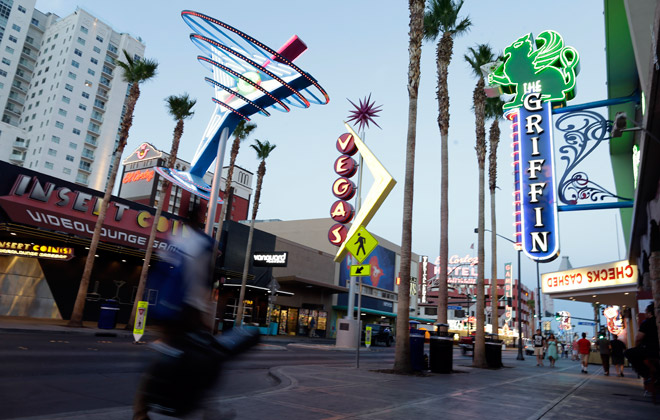Zappos helps downtown get kicking again

When Zappos, the dot-com shoe dealer, moved to central Sin City in 2012, the business jolt revitalized the formerly seedy downtown area, including East Fremont Street, shown, turning it into the hippest neighborhood in town.
From its frontier infancy through the mid-20th century, the only Las Vegas was downtown Las Vegas. But the city center known as Glitter Gulch lost the glamour battle post-1960 with the newer Strip, a stretch of Las Vegas Boulevard South with room for massive resorts featuring Egyptian pyramids and dancing water fountains.
But local politicians, entrepreneurs and preservationists never gave up on downtown, and when Zappos, the dot-com shoe dealer, moved from suburban Henderson to central Sin City in 2012, the business jolt revitalized the neighborhood, now the hippest in town.
"Las Vegas is always remaking itself," said Mark Brandenburg, president and an owner of Golden Gate Hotel Casino downtown, which was built in 1906 and remodeled in 2012. "We’re still where Las Vegas started, but now with a rebirth of casinos and retail and the arrival of Tony Hsieh."
Hsieh is the chief executive of Zappos who had the 1973-vintage City Hall adapted as the company’s headquarters, and acquired about 100 parcels of surrounding land as part of a personal $350 million investment known as the Downtown Project. It has funded everything from a retail park to a school, health center and several small business startups.
By the time Zappos arrived, a certain amount of reclamation was already underway. In 2012 several cultural draws debuted, including the Mob Museum, which tackles Las Vegas’ shady past, and the Neon Museum, preserving over 150 pieces of castoff signage.
Sensing a turnaround, new investors snapped up aging properties. The former Lady Luck opened as the 650-room Downtown Grand Hotel and Casino last fall, with a lively rooftop pool club.
Don't miss out on what's happening!
Stay in touch with breaking news, as it happens, conveniently in your email inbox. It's FREE!
Where the pedestrian portion of the carnivalesque Fremont Street ends at Las Vegas Boulevard, the new hipster Las Vegas begins.
The best way to get a feel for neo-Vegas is to take the Downtown Project tour, a free 75-minute overview that takes place almost entirely in Hsieh’s rambling private apartment on the 23rd floor of the Ogden building. My guide, Heidy Stamper, led eight mostly local guests through Hsieh’s crowded living room to a window-walled work space with panoramic views over the project’s 60 acres. The project’s most visible addition is the new Downtown Container Park, a square block ringed in re-purposed shipping containers filled with boutiques and restaurants that surround a central play area for children featuring a fanciful treehouse with a four-story slide.
Two blocks away the 200-seat Inspire Theater opened in February as a showcase for everything from indie bands to burlesque acts. It contains a coffee shop on the ground floor with an arty newsstand, a jazz bar called Wayfarer and a just-opened rooftop bar, the Roof. The venues are operated by Future Restaurant Group, owned by Michael Cornthwaite.
Cornthwaite and his wife, Jennifer, originally helped show Hsieh around downtown Las Vegas. His investment "gave downtown a shock," said Jennifer Cornthwaite, spokeswoman for the company. "It could have been a 20-year evolution." Instead, like a lucky pull on a throwback slot machine, downtown’s revival happened virtually overnight.
By Elaine Glusac, New York Times
© 2014 The New York Times Company




